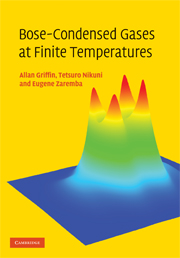Book contents
- Frontmatter
- Contents
- Preface
- 1 Overview and introduction
- 2 Condensate dynamics at T = 0
- 3 Coupled equations for the condensate and thermal cloud
- 4 Green's functions and self-energy approximations
- 5 The Beliaev and the time-dependent HFB approximations
- 6 Kadanoff–Baym derivation of the ZNG equations
- 7 Kinetic equation for Bogoliubov thermal excitations
- 8 Static thermal cloud approximation
- 9 Vortices and vortex lattices at finite temperatures
- 10 Dynamics at finite temperatures using the moment method
- 11 Numerical simulation of the ZNG equations
- 12 Simulation of collective modes at finite temperature
- 13 Landau damping in trapped Bose-condensed gases
- 14 Landau's theory of superfluidity
- 15 Two-fluid hydrodynamics in a dilute Bose gas
- 16 Variational formulation of the Landau two-fluid equations
- 17 The Landau–Khalatnikov two-fluid equations
- 18 Transport coefficients and relaxation times
- 19 General theory of damping of hydrodynamic modes
- Appendix A Monte Carlo calculation of collision rates
- Appendix B Evaluation of transport coefficients: technical details
- Appendix C Frequency-dependent transport coefficients
- Appendix D Derivation of hydrodynamic damping formula
- References
- Index
9 - Vortices and vortex lattices at finite temperatures
Published online by Cambridge University Press: 06 October 2009
- Frontmatter
- Contents
- Preface
- 1 Overview and introduction
- 2 Condensate dynamics at T = 0
- 3 Coupled equations for the condensate and thermal cloud
- 4 Green's functions and self-energy approximations
- 5 The Beliaev and the time-dependent HFB approximations
- 6 Kadanoff–Baym derivation of the ZNG equations
- 7 Kinetic equation for Bogoliubov thermal excitations
- 8 Static thermal cloud approximation
- 9 Vortices and vortex lattices at finite temperatures
- 10 Dynamics at finite temperatures using the moment method
- 11 Numerical simulation of the ZNG equations
- 12 Simulation of collective modes at finite temperature
- 13 Landau damping in trapped Bose-condensed gases
- 14 Landau's theory of superfluidity
- 15 Two-fluid hydrodynamics in a dilute Bose gas
- 16 Variational formulation of the Landau two-fluid equations
- 17 The Landau–Khalatnikov two-fluid equations
- 18 Transport coefficients and relaxation times
- 19 General theory of damping of hydrodynamic modes
- Appendix A Monte Carlo calculation of collision rates
- Appendix B Evaluation of transport coefficients: technical details
- Appendix C Frequency-dependent transport coefficients
- Appendix D Derivation of hydrodynamic damping formula
- References
- Index
Summary
The goal of creating and observing quantized vortices in trapped Bose gases arose almost immediately following the first achievements of Bose–Einstein condensation. The motivation for doing so was the obvious analogy with vortices in liquid helium and in type-II superconductors, and the fact that the quantization of circulation is directly associated with superfluid flow. It was recognized that the observation of quantized vortices could be taken as indisputable evidence for the existence of superfluidity in these systems.
The review by Fetter and Svidzinsky (2001) contains a summary of the early experiments and the theoretical background for understanding the vortex state in a weakly interacting Bose gas based on the GP equation. This material will not be repeated here apart from those aspects that have a direct bearing on the focus of the present chapter, namely the properties of vortices at finite temperature. Although there have been some theoretical contributions to this subject, much remains to be done. The discussion in this chapter provides a framework for addressing the finite-temperature properties of vortex formation and vortex lattices in the context of the ZNG theory. The results in this chapter have not been published before, apart from those in subsection 9.8.1, which are based on Williams et al. (2002).
There are several issues that relate to finite temperatures. First, there is the nucleation and formation of vortices from an initial highly nonequilibrium state. Second, there is the interaction of vortices with thermal excitations, which is responsible for the dissipative dynamics of a nonequilibrium vortex state. Third, there is the question of the final equilibrium state, with respect to the condensate and noncondensate densities in the vicinity of a vortex and to the geometrical arrangement of vortices in space.
- Type
- Chapter
- Information
- Bose-Condensed Gases at Finite Temperatures , pp. 164 - 197Publisher: Cambridge University PressPrint publication year: 2009
- 1
- Cited by



